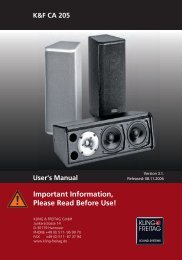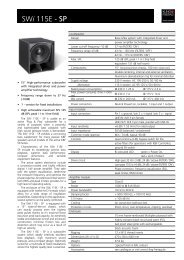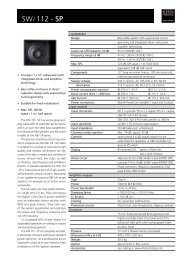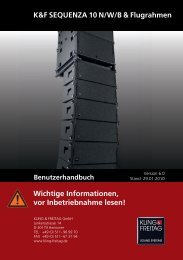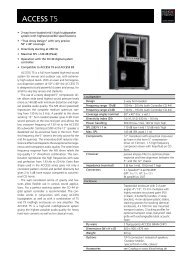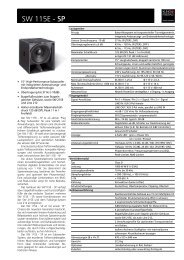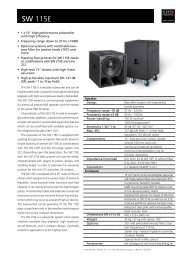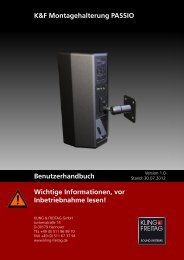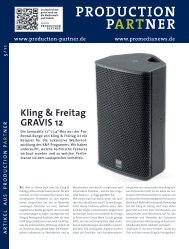Create successful ePaper yourself
Turn your PDF publications into a flip-book with our unique Google optimized e-Paper software.
User's manual<br />
System Amplifier K&F TOPAS<br />
5.5 Audio Functions<br />
5.5.1 Audio In-, Outputs<br />
5.5.1.1 Analogue Inputs<br />
Three symmetrical inputs (Channel 1, Channel 2, PRIO) are available to you. Channels 1<br />
and 2 are designed as XLR connectors [illus. C, D] with a link connector and as a clamp<br />
connector [illus. B]; the priority input is implemented as a clamp connector only [illus. A].<br />
Input sensitivity and routing can be switched (see chapter Input Sensitivity on page [24]).<br />
All analogue inputs of a channel are internally connected to one another in parallel.<br />
5.5.1.2 AES/EBU digital input (can be optionally activated)<br />
In order to apply digital audio signals you can activate the AES/EBU interface with a<br />
password. Please contact your dealer.<br />
Position<br />
A<br />
B<br />
Description<br />
Input for digital audio signals, balanced AES/EBU compatible.<br />
AES/EBU output, the signal is balanced and amplified internally.<br />
The XLR connectors and the AES/EBU interfaces are always mounted.<br />
In order to apply digital audio signals you can activate the AES/EBU interface with an<br />
optionally available password. Please contact your dealer.<br />
The interface supports the following data structures:<br />
• Sampling rate 44.1 - 96kHz<br />
• Word length 16, 18, 20 and 24bit<br />
The signal can be looped through to another device via the link connector. The signal is<br />
balanced and amplified internally.<br />
In newer devices, there is a hardware bypass to ensure that a subsequent device is not<br />
separated from a present signal in case there is no mains voltage.<br />
Under ideal circumstances, the maximum possible cable length for AES/EBU signals is approx.<br />
300 meters. Whether or not this cable length can actually be reached depends on the<br />
auxiliary device and the quality of the cabling.<br />
If there are problems with the transmission, it may be helpful to reduce the sampling rate.<br />
KLING & FREITAG GMBH © 2012 Revision 3.0 Page 22 of 65




